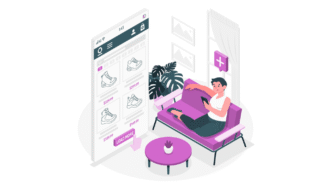LESSON OVERVIEW
With this conversation lesson plan students get plenty of opportunities to talk about their experience with English outside the classroom. They also watch a video, read three short texts and learn some useful vocabulary.
WARM-UP & VIDEO
The worksheet starts with an activity in which students talk about using English outside the classroom. There are two picture prompts and some questions to guide them. Then, students watch the video for the first time (without sound) and decide what the people might have said. They check their answers by watching the video again, with the sound on. After that, they look at five gapped sentences taken from the video and try to come up with the missing words. They watch the video one more time and check their answers. They also share their thoughts about the video and say what else they can do to practise speaking English outside the classroom.
READING & CONVERSATION
In the next task of this conversation lesson plan, students read three short texts with different suggestions of how to use English outside the classroom (e.g. apps, English-speaking meetings), and say if they have ever tried anything similar. Then, students look at the words in bold in the texts (e.g. pronunciation, improve, revise) and match them with their meanings. This activity is followed by a longer discussion. Students say what they think about the ideas, discuss the advantages and disadvantages, and come up with other ways to improve English pronunciation. After that, they look at seven more ways to practise English outside the classroom and complete gaps with words in the box (e.g. mistakes, subtitles, lyrics). This conversation lesson ends with a task in which students decide which of the ideas from the previous exercise would be best in different situations (e.g. to improve writing skills, to revise vocabulary).
Subscribe to unlock these and many other Standalone lesson with the Premium planWORKSHEETS














Hi! Firstly, your lessons are great, so thank you! I am based in Paris and I wanted to know if in this lesson, “Speaking Tables at Claire’s Café” , is this a real thing? Is the Café in London? I couldn’t find it on google!
Thank you,
Cordelia
Hi, Cordelia! I’m happy to hear you like our lessons!
The place doesn’t really exist, but the idea is based on language exchange meetings once organized by a pub in my town 🙂
This works well. Real useful for students. And great choice of video!
Thanks, Dave!
I can’t find the SpeakUp! app. Is it only available in certain countries?
Hi! The SpeakUp app doesn’t really exist. The text is just a speaking prompt for students. But as far as I know there are similar apps available.
FYI, I searched for it on the Apple App Store and found an app with the exact name, Speak Up! It’s an app to confidentially report doping violations!!! Please add a note stating that these are fake names. Other than that, it’s a real fun lesson and my learners really enjoyed it!! Thanks!!!
Sorry, I meant fictitious names.
Hi Patsy, thanks for the feedback. I’m glad the lesson was a success 🙂 Regarding your suggestion, we will consider including this kind of information in the future lessons.
Excellent lesson 😀
I really enjoy using it during the class and my students loved it!!!!
Thank you, Belen! This is awesome to hear 🙂
Great lesson with great ideas on how to improve your English. Loved the video! My Italian students didn’t get the British humour though… well you can’t expect them to… I thought it was funny!
Excellent speaking lesson! Thank you!
Thanks for your kind words, Daniela! I also found the video hilarious 🙂
Great lesson! However, I do agree with some of the commenters that suggested adding a note stating that the apps, etc., are fictitious. One of my students started searching for the app in the middle of the lesson, but I told her it was mostly likely not a real one! Also, given that many students are learning English in the US (or are being more exposed to American English), it might be an idea to provide the American alternative to some terms, e.g., revise (UK) = review (US), tick (UK) = check (US). Apart from that, your worksheets are wonderful!
Hi, thanks for your comment 🙂 Our lessons are generally written in British English. We sometimes include information about the differences between British and American vocabulary or pronunciation, but it would probably be overwhelming, especially for lower-level students, to see British and American vocabulary all in one place too often. However, we do use videos featuring speakers of American English, and so American vocabulary is learned by students as well.
And regarding the apps being made up – you (and the other commenters) have a point and so we will include some kind of a note if we use non-exisitng apps (or other inventions) in future lessons.